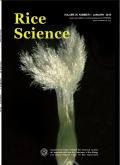Breeding Resilience: Exploring Lodging Resistance Mechanisms in Rice
IF 5.6
2区 农林科学
Q1 AGRONOMY
引用次数: 0
Abstract
Lodging is more than just plants falling over; it incurs significant economic losses for farmers leading to a decrease in both yield and quality of the final produce. Human management practices, such as dense sowing, excessive nitrogen fertilizer applications, inappropriate sowing dates, and upland rice cultivation, exacerbate the risk of lodging in rice. While breeders have developed high-yielding rice varieties utilizing the sd1 gene, relying solely on this gene is insufficient to enhance lodging resistance. Identifying the traits that contribute to lodging resistance is crucial. Key factors include biochemical, anatomical, and morphological traits, such as the levels of lignin, cellulose, hemicellulose, silicon, and potassium, along with the number and area of vascular bundles and the thickness, diameter, and length of the culm. Moreover, markers associated with lodging-related genes, like SCM2, SCM3, SCM4, and prl4, can be utilized effectively in marker-assisted backcrossing to develop rice varieties with desirable culm traits. This literature review aims to aid rice breeders in addressing the issue of lodging by examining traits that influence lodging resistance, developing phenotyping strategies for these traits, identifying suitable instrumentation, exploring methods for screening lodging-resistant plants, understanding the mathematical relationships involved, and considering molecular breeding aspects for pyramiding genes related to lodging.
育种抗逆性:水稻抗倒伏机制的探索
倒伏不仅仅是植物倒下;它给农民带来了巨大的经济损失,导致最终产品的产量和质量下降。人类的管理做法,如密集播种、过量施用氮肥、不适当的播种日期和旱稻种植,加剧了水稻倒伏的风险。虽然育种家利用sd1基因培育出了高产水稻品种,但仅仅依靠该基因不足以增强抗倒伏能力。确定有助于抗倒伏的性状是至关重要的。关键因素包括生物化学、解剖学和形态学特征,如木质素、纤维素、半纤维素、硅和钾的水平,以及维管束的数量和面积以及茎的厚度、直径和长度。此外,与倒伏相关基因相关的标记,如SCM2、SCM3、SCM4和pr14,可以在标记辅助回交中有效利用,培育出具有理想茎秆性状的水稻品种。本文献综述旨在通过研究影响倒伏抗性的性状,制定这些性状的表型策略,确定合适的仪器,探索筛选抗倒伏植物的方法,了解所涉及的数学关系,以及考虑与倒伏相关的金字塔基因的分子育种方面,帮助水稻育种者解决倒伏问题。
本文章由计算机程序翻译,如有差异,请以英文原文为准。
求助全文
约1分钟内获得全文
求助全文
来源期刊

Rice Science
Agricultural and Biological Sciences-Agronomy and Crop Science
CiteScore
8.90
自引率
6.20%
发文量
55
审稿时长
40 weeks
期刊介绍:
Rice Science is an international research journal sponsored by China National Rice Research Institute. It publishes original research papers, review articles, as well as short communications on all aspects of rice sciences in English language. Some of the topics that may be included in each issue are: breeding and genetics, biotechnology, germplasm resources, crop management, pest management, physiology, soil and fertilizer management, ecology, cereal chemistry and post-harvest processing.
 求助内容:
求助内容: 应助结果提醒方式:
应助结果提醒方式:


